Herbaceous and tuberous 2016
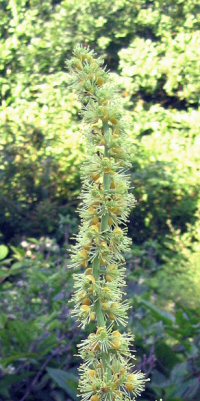 |
This season there are several more collections from our Himalayan expedition of 2013, starting with Actaea aff. foetida WJC13720 a scarce species in cultivation, which we found growing on the edge of a forested area at 3400m elevation after making our way up a deep valley in the eastern Himalayas. A medium sized perennial species to 1.2m tall, with divided basal leaves, composed of foetid leaflets. With short branched inflorescences of yellowish flowers, late summer into autumn. The seed capsules turning purple on this collection. From another nearby deep valley at a loftier 3950m we found an intriguing umbellifer, Angelica nubigena WJC13763. We could hardly believe our eyes on seeing the sturdy short stems to around 1.2m tall, topped by a wide umbel composed of several 30cm wide umbells July to September, resulting in the flat rounded seed we were collecting. The basal leaves, which were dormant at that time, are renowned as being 1m wide ovate in outline, 3-pinnately divided lobed and serrated, with conspicuously large petiole wings, more so on the upper leaves. Some consider it to be a high altitudinal form ofA. cyclocarpa, only time will tell.
|
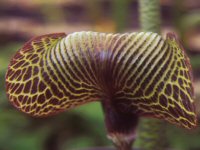 |
Another species we are introducing is Angelica breweri BSWJ14083 from the other side of the globe in California, trust this species will run the test of time too, as we have no experience in growing it as yet. Back to the This season there are several more collections from our Himalayas for Arisaema griffithii v. pradhanii WJC13660, a dramatic if only short species. With large trifoliate leaves, which are red or purple rimmed, with a spathe larger than the type, being incurved and reticulated with purple and white. The peculiar spadix is long and thin even thread-like to 50cm long.
|
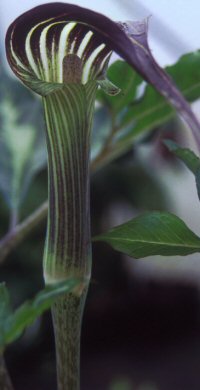 |
A second species A. angustatum v. peninsulae BSWJ8639 has been with us for quite some time, from a 2001 collection gathered from a colony growing on a steep hillside at 485m on the cold mountain of Woraksan, part of the central mountains of South Korea. With taller purple mottled stems to 90cm, bearing up to two pedate leaves, divided into 7-13, leaflets. The spathe is dark purple striped white, arching over the cylindrical spadix. We saw plenty of Cardiocrinum giganteum while in the Himalayas, hence we could afford to be a bit picky. Both collections WJC13661 & 13698 were from Sikkim and from 3m tall specimens.
|
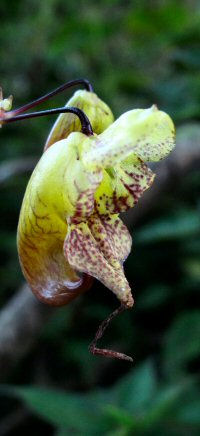
|
We also found plenty of different species of Impatiens, but as always only a few survived the passage of time I. aff. corchorifolia BSWJ13927 grew on moist ground by a fast flowing stream at 2625m at Garibash on the Singalila Ridge, West Bengal. Forming a colony of well branched stems clothed with narrow foliage and bearing dumpy yellow red veined flowers with short curved spurs. The naming is somewhat tentative, as I can only find reference to this species from China. Withdrawn as all plants destroyed due to being too invasive in our trials.
|
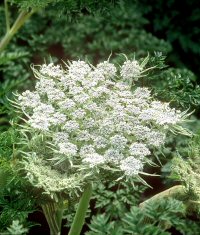 |
Ligularia aff. atkinsonii WJC13663 was also plentiful, while our second introduction of this genus is one of Dan Hinkley’s collections from China. We found L. wilsoniana growing in one of his friend’s garden, as its requirements are quite specific, cool shaded and moist, then it will flourish to a tall plant with wonderful architectural foliage. Our final Himalayan offering is merely a re-ident, apparently our Nepalese collections from 2002 of Selinum are S. carvifolium HWJK2347, all the same it’s a very popular earlier flowering species.
|
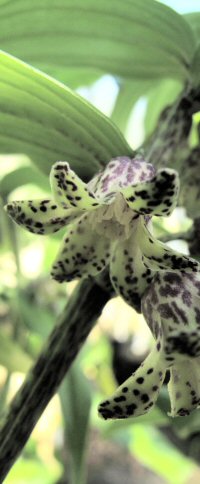 |
Disporopsis bodinieri KWJ12277 from the lofty mountains of northern Vietnam, was initially described as a new species, but soon found to be this previously described, although not cultivated species, by Aaron Floden. It is a distinct species with taller stems than most with distinct foliage far more numerous with undulating margins bearing larger flowers.
|
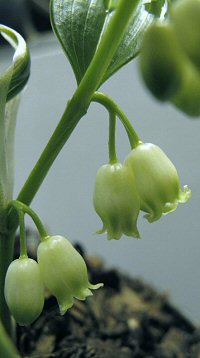 |
Heteropolygonatum urceolatum will enter cultivation with the wrong name too, again Aaron has been at it correcting this to a new species of Polygonatum. This was found in our friend Finlay Colley’s nursery in Dublin which he had acquired from the notorious Chinese nursery of Chen-Yi as Polygonatum sp. S-222. It is a short arching evergreen species of this terribly mixed up group closely related to Polygonatum punctatum that Aaron is wading his way through.
|
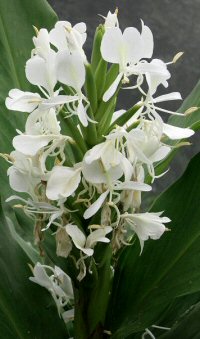 |
Back in Vietnam we are finally introducing the true long known about Hedychium forrestii Diels KWJ12314. It is quite common around the area of Sapa up in the north, but late flowering, hence little chance of flowering as far north as we are, but well worth it further south, where you have the summer heat to initiate the long succession of white scented flowers from the imbricate bracts. This collection was gathered from the highest population we could find in that area, at 1750m.
|
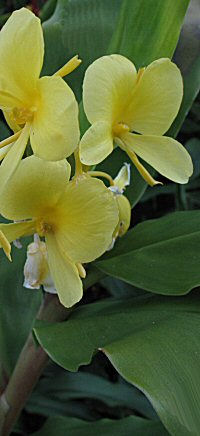
|
H. wardii will also be added this coming season, taking us a little while to build up our stock of this easily grown yellow flowering species.
|
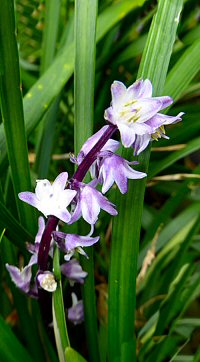
|
Ophiopogon malcolmsonii BSWJ7271 will be new to cultivation, although we have been growing this Thai species for some time. It will naturally require some shelter originating from such tropical latitudes, but nothing drastic as it is a collection from above 2,000m from the mountains in the north of the country. Where it formed large clumps of strap shaped leaves with short flowering scapes only 15cm tall.
|
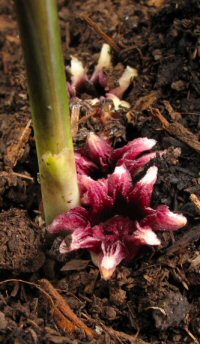 |
Encouraged by our friend Tony Avent from North Carolina we are working our way through our collections of Aspidistra applying cultivar names, which we will do at the end of this plant list. Although A. daibuensis ’Yuli Yummy’ BSWJ6863 will be an additional collection from Yuli in southern Taiwan. While on the subject, we were in Taiwan this past autumn, where we were given a copy of a paper revising the species in Taiwan, which confirmed all of our previous identifications of A. attenuata and A. daibuensis. Hence some of the affinity of (aff.) have disappeared from the list.
|
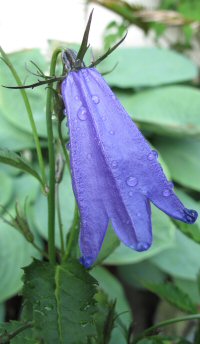 |
From the iconic Fuji-San in Japan comes Adenophora nikoensis f. linearifolia BSWJ11201, with willowy foliage on short stems. Quite alpine in its habit, but nothing too demanding as long as it has ample light and reasonable drainage.
|
 |
Moving from Asia to South America we start with a couple of white flowering species of Dahlia from Colombia, D. imperialis f. albiflora BSWJ14345 is impressive to say the least, a stunning perennial where we saw it as we were coming down from the Paramo, back towards Bogotá at 2760m. Here it formed sturdy plants only 3m tall in the relatively exposed conditions well clothed with white flowers. We have seen it previously in a more sheltered site where it easily gained 5m, but without seed.
|
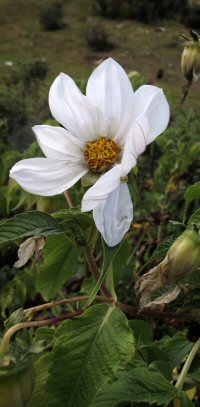
|
With similar white flowers, but usually with a splash of pale pink, is the Dahlia species from Colombia BSWJ14340, which also grew in the Bogotá basin, here generally forming sizeable colonies of 1.6m tall sturdy plants similar in habit to D. excelsa all be it shorter.
|
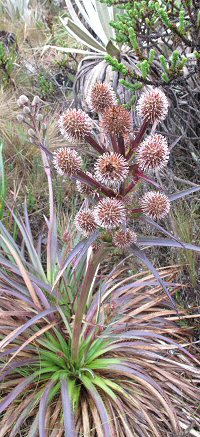
|
Eryngium humboldtii BSWJ14342 was from a much higher altitude at 3565m, from a fair ways south, where this particularly spiny species formed bronzy plants to 75cm tall with dumpy flowers.
|
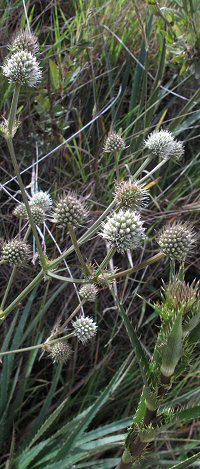
|
Another collection E. paniculatum BSWJ14367 was not so easy to identify, lacking the bronzyness and stature of the previous as well as bearing many more side branches of smaller flowers. This collection was from El Cocuy, much further north getting close to the Venezuelan border.
|
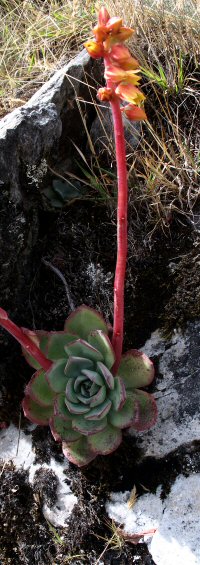
|
Here at a lofty 4100m altitude grew Echeveria bicolor BSWJ14388 strewn around a boulder covered terrain, with more choice plants that will be mentioned later. We selected the smaller more silvery form, not being a 100% sure if it was all one species, with fleshy rosettes and scaly scapes of orange flowers.
|
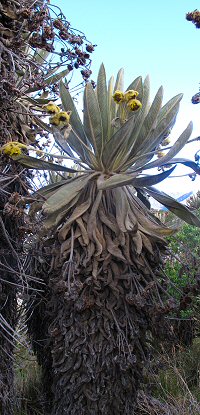 | This area proved to be a real hot bed for the species rich Espeletia, E. aff. lopezii BSWJ14374 formed a sizeable colony of plants at 3780m, with wide trunks covered with the old inflorescences of many years, to around 3m tall. Topped by narrowly elliptic silvery foliage surrounding the woolly scapes of yellow ray-flowers with large central discs, just protruding above the foliage.
|
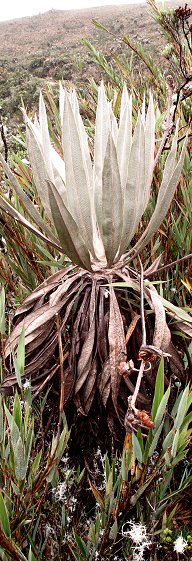
|
From another Paramo which proved very diverse at 3730m elevation, but closer to Bogota, E. killipii BSWJ14319 was a striking species, this time with only a short trunk, forming rosettes of broadly elliptic-lanceolate silvery-white woolly leaves. Meanwhile equally woolly long arching stems bore yellow shortly rayed-flowers in continuous succession.
|
 | In contrast E. uribei BSWJ14339 was a species that formed a very tall slender trunk to 4m high, but with similar silvery white woolly foliage that was quite broad on this species. While bearing sizeable ray-flowers on long scapes. This species grew at 3400m.
|
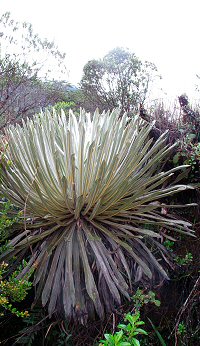 |
While lower down at 3090m as we were still climbing there were huge colonies of E. argentea BSWJ14322 a rosette forming species forming wide clumps of (as their name suggests) very silvery slender long leaves. The colonies could be measured by the acre, but long finished flowering when we saw them, only leaving us with the small numerous seed heads to gather.
|

|
We were also very pleased to find seed of the very popular Senecio niveoaureus BSWJ14320 in the same area, growing in a wet patch. Here it formed a tightly packed colony of stems to 1.5m tall well clothed in silvery-white lanceolate leaves with its sizeable showy yellow ray-flowers held in congested terminal spikes. No wonder the Colombians are always trying to grow this native species in their gardens.
|
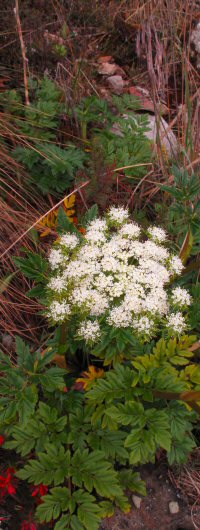
|
Ray flowers or composite flowers may predominate these lofty altitudes, but are far from the only types of plants that we find here. Myrrhidendron glaucescens BSWJ14252 is part of the umbellifer tribe of perennials, even woody trees in Costa Rica. Although on Volcán El Ruiz in southern Colombia at 4,000m altitude they formed very attractive bright white and contrasting bright green clumps of this perennial species forming small colonies only 1.5m across in the Paramo, of stems no taller than 1m. Bearing broad divided leaves on petioles that clasped the stems, topped by broad fleshy umbels 20cm across, of white aging to bright green flowers, followed by the characteristic upright elongated seed. While at a lower altitude M. pennellii BSWJ14240 was quite woody at its base with purplish stems 1.5m long, growing on a steep bank mixed with small trees and shrubs.
|
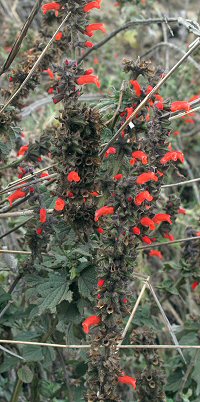 |
We found a short red flowering species of Salvia in El Cocuy, initially at a medium altitude, but then more of it as we gained altitude and reaching the Paramo. Here it formed sizeable colonies of short stems to around 30cm tall, which were entirely clothed with brown seed protecting bracts, which had born the red flowers earlier in the season. This we later identified as S. rubescens BSWJ14368, but what must be a variety of that species.
|
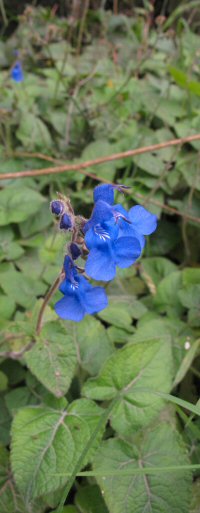
|
By contrast we also found a little charmer, S. scutellarioides BSWJ14273 a charming woodland creeping species. Growing at the edge of dense woodland forming a dense carpet of triangular or hastate overlapping foliage, studded with short spikes of bright blue wide-lipped flowers with contrasting white centers.
|
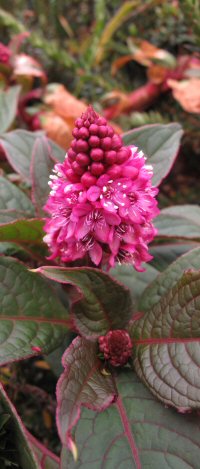
|
On our way up to Ruiz we found a wonderful form of Phytolacca bogotensis BSWJ14221 just growing on the verge, which has a low creeping habit with thick sprawling pinkish stems with generous quantities of dumpy pink upright flowering spikes. The habit could easily be attributed to the lofty 3,650m altitude we gathered its seed from.
|
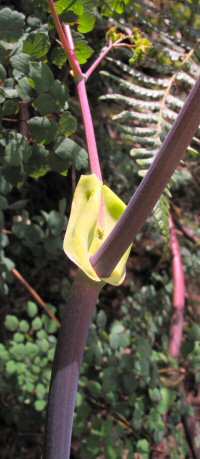
|
Thalictrum podocarpum BSWJ14297 by contrast was found growing amongst the forest edge in an area attributed to Armenia. Here they formed a sizeable colony of sprawling plants on a steep bank with thick purple stems with clasping (amplexicaul) bloomy bracts at the base of each branch. While the foliage was silvery, the wide leaves composed of numerous small leaflets. Before leaving South America a mention must be made of yet another name change thrust upon us, Libertia chilensis Elegans Group is a new name for what we have been offering as L. grandiflora for many years.
|
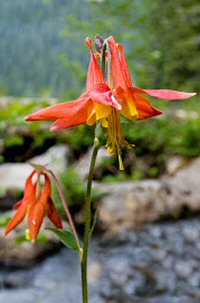 |
In recent years our travelling has taken us to North America, where we are finding plenty of plants worth growing. Aquilegia formosa v. formosa BSWJ13543 is fairly well known, but we could not resist growing this again. Encountering it on one of the trecks we made with Dan Hinkley on his home territory on Mt. Townsend, in the summer of 2013, while we were there for his wedding.
|
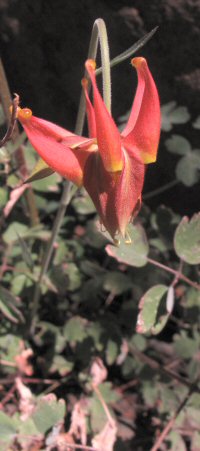
|
On our return the following year on a speaking tour of The Pacific North West, we made sure that there was plenty of time to collect. A. eximia BSWJ14053 was yet another species we were lucky to still find seed of, this time much further south in California is an isolated canyon.
|
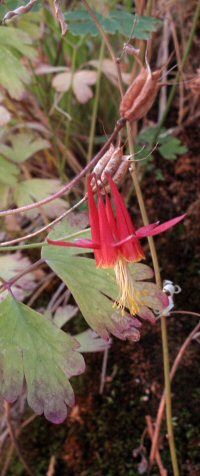 | Whereas Aquilegia formosa v. truncata BSWJ14072 was from northern California this time in the company of Sean Hogan. Sean seems to know his way around the mountains of these parts so well.
|
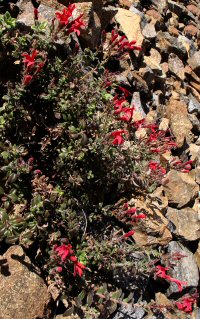 |
He pointed out Keckiella corymbosa BSWJ14096 to us at Serpentine Point, southern Oregon, at 4,400 feet growing on a steep dry bank, looking like a bright red Penstemon to our eyes.
|
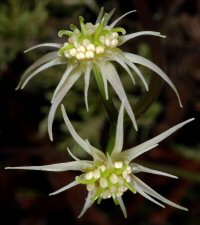 |
While our final offering from North America was from cultivation in Japan, where they appear to value the evergreen foliage of Coptis laciniata BSWJ12863 more than on the other side of the Pacific, or at least enough to offer it for sale.
|
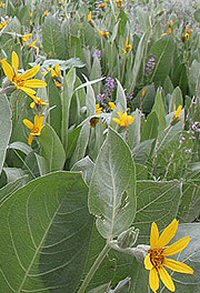 |
No mistaking which family the following two species were from, Rudbeckia californica BSWJ14105 and Wyethia mollis BSWJ14067 were both collected from this region of the mountains straddling the border between northern California and southern Oregon.
|